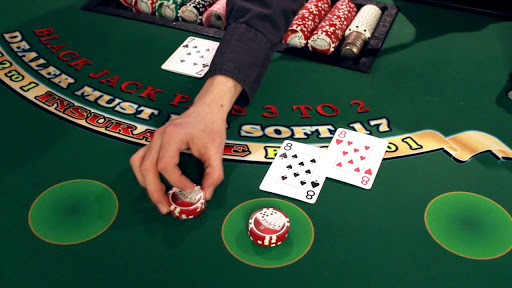Blackjack Rules and Basicss

Blackjack is a casino table game that has the reputation of the game that it is possible to beat. The popular movie “Rain man” probably has something to do with that. Well, you don’t have to be a mathematical genius to beat the dealer. You just need a lot of patience, persistence, and concentration. Here are some basic rules and terms of blackjack!
Blackjack Rules
Blackjack is one of the oldest gambling games. Some records are even saying that the old Romans invented the game. In Blackjack, players, one or more of them are competing against the dealer. Back in the days, it was played with just one 52-card deck, but now, because of card counting that we mentioned above, some casinos are shuffling from two, three, or even more decks!
Cards from 2 to 10 are worth what their number is. Royals are worth 10 each and Ace can be either 1 or 11. The goal is to draw cards until you get as close as possible to 21, without getting over. Of course, you got to have a higher sum than the dealer.
When you get a total of 21, that is Blackjack! Blackjack pays 3-2–that is, a two-card 21 on a $5 bet will win $7.50 instead of the usual $5 even-money payoff on other winning hands. However, if the dealer also has a two-card 21, the hand pushes, or ties, and you just get your original bet back. But if the dealer goes on to draw 21 in three or more cards, your blackjack is still a winner with its 3-2 payoff.
Table and start of the game
Ok, so what are the blackjack rules you may ask, it is played at the table like the one in the picture above. Seven players are the maximum that can sit at one table. The game begins when you place your stake in a square that you can see in the picture above. When all players place their bet, each of them is dealt with two cards by a dealer. Cards are dealt faceup in a classic game. They can be dealt with facedown if you are playing a double-deck game. In both cases, the dealer has to have one of his cards turned face up.
When cards have been dealt players take turns playing their hands. When all players are done it’s dealers turn. The dealer must draw more cards to any total of 16 or less and must stand on any total of 17 or more. In some casinos, the dealer will also draw to “soft” 17 — a 17 including an ace or aces that could also be counted as a 7. The most common soft 17 is ace-6, but several other totals, such as ace-3-3 or ace-4-2, on up to ace-ace-ace-ace-ace-ace-ace in a multiple deck game, are soft 17s.
Blackjack terms and hand signals
Hit
Take another card from the dealer in hope that you will get as close as possible to 21. If you got over 21, it’s a “bust” and you lost.
Hand signal: Scrape cards against table.
If cards are turned face-up: touch table with a finger wave hand towards yourself
Calling hit out loud is not accepted and it will be ignore by a dealer.
Stand
You stand when you choose not to draw any more cards and you think you have enough to beat the dealer.
Hand signal: Slide your cards under bet
If cards are turned face up: wave hand horizontally
Double down
This is basically doubling your original stake. You can double down after you have been dealt with your two cards and before any other cards have been dealt to you. After you double down, you can receive only one additional card.
Hand signal: place additional chips next to your original stake and turn your cards faceup.
If cards are turned face-up: just place additional chips next to your original stake
Split
If you have been dealt a pair in your first two cards, you get an option to split those cards. This means you may elect to make a second bet equal to your first and split the pair, using each card as the first card in a separate hand. For example, if you are dealt two 9s, you may slide a second stake equal to the first one. The dealer will separate the cards, then put a second card on the first one. You play that hand out as you would normally do until you either stand or bust; then the dealer puts a second card on the second 8, and you play that hand.
Hand signal: place additional stake next to the one that you originally made
Insurance
In the table photo above you probably saw the word “insurance”. You can take this “insurance” if a face-up card that dealer has is an ace. Insurance actually means that you can bet half your original wager and it pays 2 to 1. You can usually only bet half the amount of the original bet you made on the hand. If the dealer makes a blackjack, your profit on the insurance bet will be equal to the amount you bet on insurance. If the dealer doesn’t make a blackjack you lose your insurance bet.
These would be the very basics of the game. Keep in mind that Blackjack is much more than this. It has many variations and codes of play, but we will leave that for some other time. For now, good luck and practice on Blackjack games where no real money is involved. At least until you get a grip on the basics that we covered in this article.
Why not try out your newly learned skills at Mr Vegas, they have a huge selection of Blackjack games to play.

